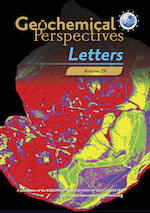Preservation of the isotope signatures in chondritic IOM during aqueous alteration
Affiliations | Corresponding Author | Cite as | Funding information- Share this article





-
Article views:137Cumulative count of HTML views and PDF downloads.
- Download Citation
- Rights & Permissions
top
Abstract

Figures
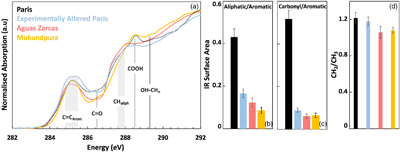 Figure 1 Spectroscopy investigations. (a) Speciation of organic carbon using near edge X-ray absorption fine structure for Paris (black), the experimentally altered Paris (‘Altered Paris’, blue), and altered CM2 Aguas Zarcas (pink) and Mukundpura (yellow) IOMs. The spectra are dominated by aromatic, carbonyl or carboxylic functional groups, with only a minor contribution of aliphatic groups. (b, c), Relative evolution of infrared surface area for aliphatic and carbonyl bands, relative to aromatic carbon. (d) Intensity ratio for aliphatic CH2 (2925 cm−1) and CH3 (2960 cm−1) bands. | 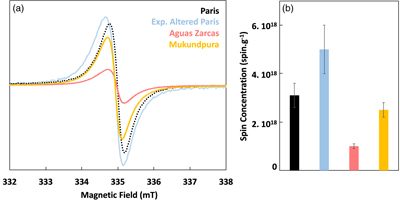 Figure 2 Detection of organic radicals after experimental alteration. (a) Spectra (microwave absorption derivative) at 280–285 K for experimentally altered Paris (blue), CM2.7 Paris (black) and CM2.2 Aguas Zarcas (red) and CM2.0 Mukundpura (yellow). (b) Concentrations of radicals at 280–285 K. | 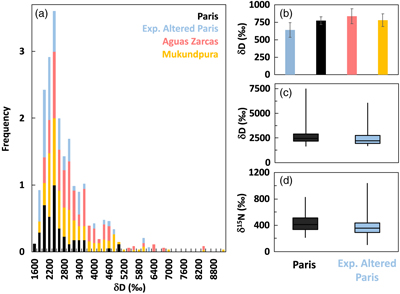 Figure 3 NanoSIMS investigations. (a) Normalised deuterium-rich hotspot distributions in IOM and bulk hydrogen isotopic compositions of Paris (black), experimentally altered Paris CM2 Aguas Zarcas (pink) and Mukundpura (yellow). Distribution are normalised to the number of occurrences and stacked. (b) The bulk hydrogen isotopic compositions of the different CMs and the experimental residue. (c, d) Evolution of the hotspot signatures for hydrogen (analysed on 3600 μm2 surface) and nitrogen isotopes (analysed on 2400 μm2 surface; images are reported on Fig. S-4). | 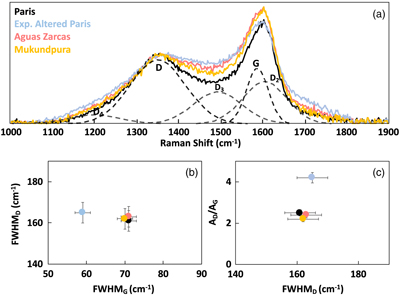 Figure 4 Structural evolution of Paris IOM under asteroidal conditions. (a) Raman spectra of Paris (black), experimentally altered Paris H2O (‘Altered Paris’, blue), and altered CM2 Aguas Zarcas (pink) and Mukundpura (yellow). Positions of G, D and minor defect bands are also reported. (b) Comparison of Raman D and G band widths for Paris (black), experimentally altered Paris (blue) and altered CM2 Aguas Zarcas (pink) and Mukundpura (yellow). (c) Evolution of band surface area ratio as function D band width for altered Paris, and the natural objects. |
| Figure 1 | Figure 2 | Figure 3 | Figure 4 |
top
Letter
Carbonaceous chondrites are likely fragments of C-complex asteroids (Vernazza et al., 2017
Vernazza, P., Castillo-Rogez, J., Beck, P., Emery, J., Brunetto, R., Delbo, M., Marsset, M., Marchis, F., Groussin, O., Zanda, B., Lamy, P., Mousis, O., Delsanti, A., Djouadi, Z., Dionnet Z., Borondics, F., Carry, B. (2017) Different origins or different evolutions? Decoding the spectral diversity among C-type asteroids. The Astronomical Journal 153, 72. https://doi.org/10.3847/1538-3881/153/2/72
), containing a significant amount of organic matter which may have contributed to the organic inventory of the early Earth. Representing 25 % of the carbonaceous chondrites collected so far (Gounelle et al., 2005Gounelle, M., Engrand, C., Alard, O., Bland, P.A., Zolensky, M.E., Russell, S.S., Duprat, J. (2005) Hydrogen isotopic composition of water from fossil micrometeorites in howardites. Geochimica et Cosmochimica Acta 69, 3431–3443. https://doi.org/10.1016/j.gca.2004.12.021
), the CMs are among the most primitive objects in the solar system at our disposition. Yet all CMs have experienced various degrees of aqueous alteration, as evidenced by the presence of numerous secondary minerals (Brearley, 2006Brearley, A.J. (2006) The action of water. Meteorites and the Early Solar System II 943, 587–624.
; Le Guillou et al., 2012Le Guillou, C., Rouzaud, J. N., Bonal, L., Quirico, E., Derenne, S., Remusat, L. (2012) High resolution TEM of chondritic carbonaceous matter: Metamorphic evolution and heterogeneity. Meteoritics & Planetary Science 47, 345–362. https://doi.org/10.1111/j.1945-5100.2012.01336.x
; Howard et al., 2015Howard, K.T., Alexander, C.M.O'D, Schrader, D.L., Dyl, K.A. (2015) Classification of hydrous meteorites (CR, CM and C2 ungrouped) by phyllosilicate fraction: PSD-XRD modal mineralogy and planetesimal environments. Geochimica et Cosmochimica Acta 149, 206–222. https://doi.org/10.1016/j.gca.2014.10.025
), yielding both weakly altered objects, such as Paris (Hewins et al., 2014Hewins, R.H., Bourot-Denise, M., Zanda, B., Leroux, H., Barrat, J.A., Humayun, M., Göpel, C., Greenwood, R.C., Franchi, I.A., Pont, S., Lorand, J.P., Cournede, C., Gattacceca, J., Rochette, P., Kuga, M., Marrocchi, Y., Marty, B. (2014) The Paris meteorite, the least altered CM chondrite so far. Geochimica et Cosmochimica Acta 124, 190–222. https://doi.org/10.1016/j.gca.2013.09.014
) or Asuka (A)-12236 (Glavin et al., 2020Glavin, D.P., McLain, H.L., Dworkin, J.P., Parker, E.T., Elsila, J.E., Aponte, J.C., Simkus, D.N., Pozarychi, C.I., Graham, H.V., Nittler, L., Alexander, C.M.O.D. (2020) Abundant extraterrestrial amino acids in the primitive CM carbonaceous chondrite Asuka 12236. Meteoritics & Planetary Science 55, 1979–2006. https://doi.org/10.1111/maps.13560
), and moderately to totally altered objects in which primary phases have all been replaced. Therefore, a deeper knowledge of the effect of aqueous alteration processes is essential to build a reliable vision of the nature of the primordial, unaltered organic reservoir of CMs.The CMs exhibit the highest organic carbon contents of all chondrites, with values ranging from 1.5 to 3.4 wt. % (Vacher et al., 2020
Vacher, L.G., Piani, L., Rigaudier, T., Thomassin, D., Florin, G., Piralla, M., Marrocchi, Y. (2020) Hydrogen in chondrites: Influence of parent body alteration and atmospheric contamination on primordial components. Geochimica et Cosmochimica Acta 281, 53–66. https://doi.org/10.1016/j.gca.2020.05.007
). Most of this organic component consists of an insoluble organic matter (IOM); macromolecules with rather small aromatic units showing a high degree of crosslinking (Derenne and Robert, 2010Derenne, S., Robert, F. (2010) Model of molecular structure of the insoluble organic matter isolated from Murchison meteorite. Meteoritics & Planetary Science 45, 1461–1475. https://doi.org/10.1111/j.1945-5100.2010.01122.x
; Orthous-Daunay et al., 2013Orthous-Daunay, F.R., Quirico, E., Beck, P., Brissaud, O., Dartois, E., Pino, T., Schmitt, B. (2013) Mid-infrared study of the molecular structure variability of insoluble organic matter from primitive chondrites. Icarus 223, 534–543. https://doi.org/10.1016/j.icarus.2013.01.003
). Of note, the IOM of the most altered CMs are chemically different from those of the least altered CMs known so far (i.e. Paris and Asuka (A)-12236; see Vinogradoff et al., 2017Vinogradoff, V., Le Guillou, C., Bernard, S., Binet, L., Cartigny, P., Brearley, A.J., Remusat, L. (2017) Paris vs. Murchison: Impact of hydrothermal alteration on organic matter in CM chondrites. Geochimica et Cosmochimica Acta 212, 234–252. https://doi.org/10.1016/j.gca.2017.06.009
; Glavin et al., 2020Glavin, D.P., McLain, H.L., Dworkin, J.P., Parker, E.T., Elsila, J.E., Aponte, J.C., Simkus, D.N., Pozarychi, C.I., Graham, H.V., Nittler, L., Alexander, C.M.O.D. (2020) Abundant extraterrestrial amino acids in the primitive CM carbonaceous chondrite Asuka 12236. Meteoritics & Planetary Science 55, 1979–2006. https://doi.org/10.1111/maps.13560
). This suggests that the IOM could serve as a chemical tracer of aqueous alteration, and that its early nature can eventually be reconstructed.Laboratory experiments constitute the most appropriate way to properly constrain the evolution of chondritic IOM during fluid circulation in the asteroidal stage. IOM has been previously shown to experience aromatisation if submitted to high temperature (Okumura and Mimura, 2011
Okumura, F., Mimura, K. (2011) Gradual and stepwise pyrolyses of insoluble organic matter from the Murchison meteorite revealing chemical structure and isotopic distribution. Geochimica et Cosmochimica Acta 75, 7063–7080. https://doi.org/10.1016/j.gca.2011.09.015
; Remusat et al., 2019Remusat, L., Bonnet, J.Y., Bernard, S., Buch, A., Quirico, E. (2019) Molecular and isotopic behavior of insoluble organic matter of the Orgueil meteorite upon heating. Geochimica et Cosmochimica Acta 263, 235–247. https://doi.org/10.1016/j.gca.2019.07.013
), as well as significant deuterium depletion (Yabuta et al., 2007Yabuta, H., Williams, L.B., Cody, G.D., Alexander, C.M.O.D., Pizzarello, S. (2007) The insoluble carbonaceous material of CM chondrites: A possible source of discrete organic compounds under hydrothermal conditions. Meteoritics & Planetary Science 42, 37–48. https://doi.org/10.1111/j.1945-5100.2007.tb00216.x
; Oba and Naraoka, 2009Oba, Y., Naraoka, H. (2009) Elemental and isotope behavior of macromolecular organic matter from CM chondrites during hydrous pyrolysis. Meteoritics & Planetary Science 44, 943–953. https://doi.org/10.1111/j.1945-5100.2009.tb00779.x
; Foustoukos et al., 2021Foustoukos, D.I., Alexander, C.M.O’D., Cody, G.D. (2021) H and N systematics in thermally altered chondritic insoluble organic matter: An experimental study. Geochimica et Cosmochimica Acta 300, 44–64. https://doi.org/10.1016/j.gca.2021.01.021
), with final D/H values depending on that of the fluid if present. This evolution is significant above 300 °C (Oba and Naraoka, 2009Oba, Y., Naraoka, H. (2009) Elemental and isotope behavior of macromolecular organic matter from CM chondrites during hydrous pyrolysis. Meteoritics & Planetary Science 44, 943–953. https://doi.org/10.1111/j.1945-5100.2009.tb00779.x
), although the temperature dependence remains limited between 250 and 450 °C (Foustoukos et al., 2021Foustoukos, D.I., Alexander, C.M.O’D., Cody, G.D. (2021) H and N systematics in thermally altered chondritic insoluble organic matter: An experimental study. Geochimica et Cosmochimica Acta 300, 44–64. https://doi.org/10.1016/j.gca.2021.01.021
). While these high temperatures certainly reconcile laboratory limitations and astrophysical processes by potentially simulating very slow processes using short duration experiments, they are well beyond the peak temperature undergone by CMs. Although some authors concluded that carbonates were formed at temperature as high as 350 °C, the peak temperature undergone by CMs may not be that far above 100 °C (Guo and Eiler, 2007Guo, W., Eiler, J.M. (2007) Temperatures of aqueous alteration and evidence for methane generation on the parent bodies of the CM chondrites. Geochimica et Cosmochimica Acta 71, 5565–5575. https://doi.org/10.1016/j.gca.2007.07.029
; Verdier-Paoletti et al., 2017Verdier-Paoletti, M. J., Marrocchi, Y., Avice, G., Roskosz, M., Gurenko, A., Gounelle, M. (2017) Oxygen isotope constraints on the alteration temperatures of CM chondrites. Earth and Planetary Science Letters 458, 273–281. https://doi.org/10.1016/j.epsl.2016.10.055
). In that context, we subjected the IOM isolated from the weakly altered Paris (CM2.7) to hydrothermal conditions (150 °C in the presence of liquid water) for 49 days and compared the experimental residue (hereafter referred to as ‘experimentally altered Paris’) to IOM of newly recovered and extensively altered CMs, namely Aguas Zarcas (CM2.2; Martin and Lee, 2020Martin, P.M.C., Lee, M.E. (2020) Degree of Aqueous Alteration of the CM Carbonaceous Chondrite Aguas Zarcas: Implications for Understanding Ryugu and Bennu. 51st Lunar and Planetary Science Conference, abstract #2326.
) and Mukundpura (CM2.0; Rudraswami et al., 2019Rudraswami, N.G., Naik, A.K., Tripathi, R.P., Bhandari, N., Karapurkar, S.G., Prasad, M. S., Babu, E.V.S.S.K., Sarathi, U.V. (2019) Chemical, isotopic and amino acid composition of Mukundpura CM2.0 (CM1) chondrite: Evidence of parent body aqueous alteration. Geoscience Frontiers 10, 495–504. https://doi.org/10.1016/j.gsf.2018.02.001.
). Alteration indices for CMs follows classification from Rubin et al. (2007)Rubin, A.E., Trigo-Rodríguez, J.M., Huber, H., Wasson, J.T. (2007) Progressive aqueous alteration of CM carbonaceous chondrites. Geochimica et Cosmochimica Acta 71, 9, 2361–2382. https://doi.org/10.1016/j.gca.2007.02.008.
based on chemistry and mineralogical evidence, with subtypes defined from totally altered (2.0) to not altered (3.0). The molecular structure of the experimental residue was analysed using X-ray absorption near edge structure (XANES) spectroscopy, Fourier transform infrared (FTIR) spectroscopy and time-of-flight secondary ion mass spectrometry (ToF-SIMS). The radicals in the IOM structure were detected through electron paramagnetic resonance (EPR). The distribution of D- and 15N-rich hotspots was imaged by NanoSIMS. The limited amount of recovered IOM only allowed elemental ratios determination via NanoSIMS imaging method for the residue (Remusat et al., 2019Remusat, L., Bonnet, J.Y., Bernard, S., Buch, A., Quirico, E. (2019) Molecular and isotopic behavior of insoluble organic matter of the Orgueil meteorite upon heating. Geochimica et Cosmochimica Acta 263, 235–247. https://doi.org/10.1016/j.gca.2019.07.013
). Finally, the degree of carbon organisation was probed using Raman microspectroscopy.The elemental composition of the Paris IOM experienced modifications during the experiment. Although the S/C value of the residue is not that different from that of the starting material, its N/C value is lower (by about 15 %) and its O/C value is significantly lower (by about 30 %) as indicated by NanoSIMS (Fig. S-1). The stability at elevated temperature of S-rich groups in IOM was previously established (Oba and Naraoka, 2009
Oba, Y., Naraoka, H. (2009) Elemental and isotope behavior of macromolecular organic matter from CM chondrites during hydrous pyrolysis. Meteoritics & Planetary Science 44, 943–953. https://doi.org/10.1111/j.1945-5100.2009.tb00779.x
; Okumura and Mimura, 2011Okumura, F., Mimura, K. (2011) Gradual and stepwise pyrolyses of insoluble organic matter from the Murchison meteorite revealing chemical structure and isotopic distribution. Geochimica et Cosmochimica Acta 75, 7063–7080. https://doi.org/10.1016/j.gca.2011.09.015
). From the XANES spectra, normalised to the total carbon atoms probed, all IOM here are dominated by aromatic groups and contain various amounts of carbonyl, carboxylic and aliphatic carbons (Fig. 1a). The widening of the aromatic peak towards 285.5 eV observed in the spectrum of the experimental residue indicates the presence of conjugated rings (Bernard et al., 2010Bernard, S., Beyssac, O., Benzerara, K., Findling, N., Tzvetkov, G., Brown Jr, G.E. (2010) XANES, Raman and XRD study of anthracene-based cokes and saccharose-based chars submitted to high-temperature pyrolysis. Carbon 48, 2506–2516. https://doi.org/10.1016/j.carbon.2010.03.024
), evidencing ongoing graphitisation. The experimental residue seemingly contains as low oxygen as the IOM of Aguas Zarcas and Mukundpura (Fig. 1a).
Figure 1 Spectroscopy investigations. (a) Speciation of organic carbon using near edge X-ray absorption fine structure for Paris (black), the experimentally altered Paris (‘Altered Paris’, blue), and altered CM2 Aguas Zarcas (pink) and Mukundpura (yellow) IOMs. The spectra are dominated by aromatic, carbonyl or carboxylic functional groups, with only a minor contribution of aliphatic groups. (b, c), Relative evolution of infrared surface area for aliphatic and carbonyl bands, relative to aromatic carbon. (d) Intensity ratio for aliphatic CH2 (2925 cm−1) and CH3 (2960 cm−1) bands.
These results are confirmed by infrared spectroscopy (Fig. 1b,c; IR spectra are reported in Fig. S-2). The experimental residue contains about as many carbonyl groups as the Aguas Zarcas and Mukundpura IOM, i.e. significantly fewer than the Paris IOM (Fig. 1b,c). Its aliphatic content is low compared to Paris IOM, but higher than in the Aguas Zarcas and Mukundpura IOM. Yet, the CH2/CH3 of the residue is only slightly lower than that of the Paris IOM, while Aguas Zarcas and Mukundpura IOM have the lower values. The increase of aromaticity during the experiment is also confirmed by TOF-SIMS, with a relatively higher concentration of aromatic cycles in the residue compared to that of the Paris IOM (Fig. S-3b). Altogether, these spectroscopy and mass spectrometry investigations illustrate that, when exposed to hydrothermal conditions, Paris IOM chemically evolves towards the Aguas Zarcas and Mukundpura. The EPR spectra of the IOMs and of the experimental residue also provide information on the concentration of radicals (Fig. 2a). Concomitantly to the increase of aromaticity, the abundance of radicals detected increases significantly during the experiment, with a 1.6 times higher content in the experimental residue than in the Paris IOM near room temperature (Fig. 2b). The concentration of radicals in the experimental residue is systematically higher than in the Aguas Zarcas and Mukundpura IOM, Aguas Zarcas having the lowest abundance.

Figure 2 Detection of organic radicals after experimental alteration. (a) Spectra (microwave absorption derivative) at 280–285 K for experimentally altered Paris (blue), CM2.7 Paris (black) and CM2.2 Aguas Zarcas (red) and CM2.0 Mukundpura (yellow). (b) Concentrations of radicals at 280–285 K.

Figure 3 NanoSIMS investigations. (a) Normalised deuterium-rich hotspot distributions in IOM and bulk hydrogen isotopic compositions of Paris (black), experimentally altered Paris CM2 Aguas Zarcas (pink) and Mukundpura (yellow). Distribution are normalised to the number of occurrences and stacked. (b) The bulk hydrogen isotopic compositions of the different CMs and the experimental residue. (c, d) Evolution of the hotspot signatures for hydrogen (analysed on 3600 μm2 surface) and nitrogen isotopes (analysed on 2400 μm2 surface; images are reported on Fig. S-4).
The IOM of the CM here show identical bulk hydrogen isotopic compositions within error bars (Fig. 3b for δD values of 773 ± 56 ‰ for Paris, 836 ± 116 ‰ for Aguas Zarcas and 780 ± 91 ‰ for Mukundpura). The experimental residue is slightly smaller but remains similar within error bars (δD = 640 ± 105 ‰), and consistent with experimental study on IOM analogues (Kebukawa et al., 2021
Kebukawa, Y., Kobayashi, S., Kawasaki, N., Wang, Y., Yurimoto, H., Cody, G.D. (2021) Hydrogen isotopic exchange kinetics between organic matter and water : Implications for chemical evolution during meteorite parent body processing. Meteoritics & Planetary Science 56, 440–454. https://doi.org/10.1111/maps.13629
). D-rich hotspots usually observed in IOM of CMs (Busemann et al., 2006Busemann, H., Young, A.F., Alexander, C.M.O.D., Hoppe, P., Mukhopadhyay, S., Nittler, L.R. (2006) Interstellar chemistry recorded in organic matter from primitive meteorites. Science 312(5774), 727–730. https://doi.org/10.1126/science.1123878
; Remusat et al., 2009Remusat, L., Robert, F., Meibom, A., Mostefaoui, S., Delpoux, O., Binet, L., Gourier, D., Derenne, S. (2009) Proto-planetary disk chemistry recorded by D-rich organic radicals in carbonaceous chondrites. The Astrophysical Journal 698, 2087. https://doi.org/10.1088/0004-637X/698/2/2087.
) are still observed after the experiment (Fig. 3a), with a distribution of δD values closer to that of Aguas Zarcas and Mukundpura than to that of Paris, as exemplified by δD values ranging from 2800 and 3600 ‰ (Fig. 3a). This effect does not arise from the hotspot distribution, which show only little modification (Fig. 3c,d). Nevertheless, the present results differ from results of pyrolysis experiments having evidenced that D-rich hotspots could not withstand high temperature (Remusat et al., 2009Remusat, L., Robert, F., Meibom, A., Mostefaoui, S., Delpoux, O., Binet, L., Gourier, D., Derenne, S. (2009) Proto-planetary disk chemistry recorded by D-rich organic radicals in carbonaceous chondrites. The Astrophysical Journal 698, 2087. https://doi.org/10.1088/0004-637X/698/2/2087.
, 2019Remusat, L., Bonnet, J.Y., Bernard, S., Buch, A., Quirico, E. (2019) Molecular and isotopic behavior of insoluble organic matter of the Orgueil meteorite upon heating. Geochimica et Cosmochimica Acta 263, 235–247. https://doi.org/10.1016/j.gca.2019.07.013
). If hotspots are unaffected by fluid interactions at 150 °C, then their measured isotopic compositions may reasonably correspond to pre-accretion composition of organic grains exposed to various conditions in the protosolar nebula (Remusat et al., 2010Remusat, L., Guan, Y., Wang, Y., Eiler, J.M. (2010). Accretion and preservation of D-rich organic particles in carbonaceous chondrites: Evidence for important transport in the early solar system nebula. The Astrophysical Journal 713(2), 1048. https://doi.org/10.1088/0004-637X/713/2/1048
).The Raman spectra of the experimental residue and from the natural objects exhibit two main bands, the so-called defect (D, 1355 cm−1) and graphite (G, 1595 cm−1) bands (Fig. 4a). These two bands are broad for all the samples, and correspond to a highly disordered carbon structure, typical of low thermal alteration (Quirico et al., 2018
Quirico, E., Bonal, L., Beck, P., Yabuta, H., Nakamura, T., Nakato, A., Flandinet, L., Montagnac, G., Schmitt-Kopplin, P., Herd, C.D.K. (2018) Prevalence and nature of heating processes in CM and C2-ungrouped chondrites as revealed by insoluble organic matter. Geochimica et Cosmochimica Acta 241, 17–37. https://doi.org/10.1016/j.gca.2018.08.029
). All CMs here present similar band widths (FWHMD,G) and surface area ratios (AD/AG; Fig. 4b,c). However, the Raman spectrum of the experimental residue is different and rather corresponds to carbonaceous material with an apparent lower degree of carbon organisation, even though it contains more conjugated cycles as indicated by its XANES spectrum.
Figure 4 Structural evolution of Paris IOM under asteroidal conditions. (a) Raman spectra of Paris (black), experimentally altered Paris H2O (‘Altered Paris’, blue), and altered CM2 Aguas Zarcas (pink) and Mukundpura (yellow). Positions of G, D and minor defect bands are also reported. (b) Comparison of Raman D and G band widths for Paris (black), experimentally altered Paris (blue) and altered CM2 Aguas Zarcas (pink) and Mukundpura (yellow). (c) Evolution of band surface area ratio as function D band width for altered Paris, and the natural objects.
All considered, the experimental residue is chemically similar to the IOM of CMs having undergone aqueous alteration (Fig. 1). In contrast to the common belief that radicals should be destroyed during alteration, the residue also contains an additional population of radicals easily detected at room temperature (Fig. 2b). Its isotopic composition is not that different from that of the Paris IOM, while its microstructure (i.e. its degree of carbon organisation) differs from that of both the Paris, Aguas Zarcas and Mukundpura IOM. Based upon the present results, we suggest that aqueous alteration is not solely responsible for the differences existing between the CM, hence pre-accretion signatures are still detected in natural objects. Nevertheless, we cannot exclude that the present experimental conditions do not perfectly mimic those of natural settings. For these experiments to be closer to the conditions existing in the parent body of CMs, additional parameters should have been considered, such as the presence of mineral phases. Clay minerals constitute the main phase of aqueously altered chondrites (Beck et al., 2010
Beck, P., Quirico, E., Montes-Hernandez, G., Bonal, L., Bollard, J., Orthous-Daunay, F. R., Howard, K.T, Schmitt, B., Brissaud, O., Deschamps, F., Wunder, B., Guillot, S. (2010) Hydrous mineralogy of CM and CI chondrites from infrared spectroscopy and their relationship with low albedo asteroids. Geochimica et Cosmochimica Acta 74, 4881–4892. https://doi.org/10.1016/j.gca.2010.05.020
) and are closely associated with organic matter in chondrites (Le Guillou et al., 2014Le Guillou, C., Bernard, S., Brearley, A.J., Remusat, L. (2014) Evolution of organic matter in Orgueil, Murchison and Renazzo during parent body aqueous alteration: In situ investigations. Geochimica et Cosmochimica Acta 131, 368–392. https://doi.org/10.1016/j.gca.2013.11.020
). Clay minerals can in fact adsorb, trap and/or store organic molecules (Lagaly et al., 2013Lagaly, G., Ogawa, M., Dékány, I. (2013) Clay mineral–organic interactions. Developments in Clay Science 5, 435–505. https://doi.org/10.1016/B978-0-08-098258-8.00015-8
), and possibly inhibit the production of IOM under asteroidal conditions (Viennet et al., 2022Viennet, J.C., Le Guillou, C., Remusat, L., Baron, F., Delbes, L., Blanchenet, A.M., Laurent, B., Criouet, I., Bernard, S. (2022). Experimental investigation of Fe-clay/organic interactions under asteroidal conditions. Geochimica et Cosmochimica Acta 318, 352–365. https://doi.org/10.1016/j.gca.2021.12.002
). A potential key limitation here could be the strict closed system conditions under which the present experiments have been conducted. While it is consistent with the isochemical alteration undergone by primitive chondrites (Bland et al., 2009Bland, P.A., Jackson, M.D., Coker, R.F., Cohen, B.A., Webber, J.B.W., Lee, M.R., Duffy, C.M., Chater, R.J., Ardakani, M.G., McPhail, D.S., McComb, D.W., Benedix, G.K. (2009) Why aqueous alteration in asteroids was isochemical: High porosity≠ high permeability. Earth and Planetary Science Letters 287, 559–568. https://doi.org/10.1016/j.epsl.2009.09.004
), the diversity of d18O values of the minerals phases comprising CM2s (e.g., Kimura et al., 2020Kimura, M., Imae, N., Komatsu, M., Barrat, J.A., Greenwood, R.C., Yamaguchi, A., Noguchi, T. (2020) The most primitive CM chondrites, Asuka 12085, 12169, and 12236, of subtypes 3.0–2.8: Their characteristic features and classification. Polar Science 26, 100565. https://doi.org/10.1016/j.polar.2020.100565
) pleads in favour of a relatively open system. Hence, while showing chemical and isotopic composition congruent with altered chondritic matter, the present study highlights the need for further experiments to better constrain the effect of aqueous alteration on the chemical, isotopic and structural evolution of IOM during asteroidal aqueous alteration and eventually build a reliable vision of the nature of the primordial, unaltered organic reservoir of CMs.top
Acknowledgements
This work was supported by the European Research Council via the ERC project HYDROMA (grant agreement No. 819587). The NanoSIMS facility at the Muséum National d’Histoire Naturelle in Paris was established by funds from the CNRS, Région Ile de France, Ministère délégué à l’Enseignement supérieur et à la Recherche, and the Muséum National d’Histoire Naturelle. We thank F. Borondics and C. Sandt for precious help at the SMIS beamline. The FTIR micro-spectroscopy measurements were supported by grants from Region Ile-de-France (DIM-ACAV) and SOLEIL. Boris Laurent thanks Olivier Beyssac for his technical help and advices. We thank Dionysis Foustoukos and the two anonymous reviewers for their valuable comments, and Francis McCubbin for editorial handling.
Editor: Francis McCubbin
top
References
Bernard, S., Beyssac, O., Benzerara, K., Findling, N., Tzvetkov, G., Brown Jr, G.E. (2010) XANES, Raman and XRD study of anthracene-based cokes and saccharose-based chars submitted to high-temperature pyrolysis. Carbon 48, 2506–2516. https://doi.org/10.1016/j.carbon.2010.03.024
 Show in context
Show in context The widening of the aromatic peak towards 285.5 eV observed in the spectrum of the experimental residue indicates the presence of conjugated rings (Bernard et al., 2010), evidencing ongoing graphitisation.
View in article
Bland, P.A., Jackson, M.D., Coker, R.F., Cohen, B.A., Webber, J.B.W., Lee, M.R., Duffy, C.M., Chater, R.J., Ardakani, M.G., McPhail, D.S., McComb, D.W., Benedix, G.K. (2009) Why aqueous alteration in asteroids was isochemical: High porosity≠ high permeability. Earth and Planetary Science Letters 287, 559–568. https://doi.org/10.1016/j.epsl.2009.09.004
 Show in context
Show in context While it is consistent with the isochemical alteration undergone by primitive chondrites (Bland et al., 2009), the diversity of d18O values of the minerals phases comprising CM2s (e.g., Kimura et al., 2020) pleads in favour of a relatively open system.
View in article
Beck, P., Quirico, E., Montes-Hernandez, G., Bonal, L., Bollard, J., Orthous-Daunay, F. R., Howard, K.T, Schmitt, B., Brissaud, O., Deschamps, F., Wunder, B., Guillot, S. (2010) Hydrous mineralogy of CM and CI chondrites from infrared spectroscopy and their relationship with low albedo asteroids. Geochimica et Cosmochimica Acta 74, 4881–4892. https://doi.org/10.1016/j.gca.2010.05.020
 Show in context
Show in context Clay minerals constitute the main phase of aqueously altered chondrites (Beck et al., 2010) and are closely associated with organic matter in chondrites (Le Guillou et al., 2014).
View in article
Brearley, A.J. (2006) The action of water. Meteorites and the Early Solar System II 943, 587–624.
 Show in context
Show in context Yet all CMs have experienced various degrees of aqueous alteration, as evidenced by the presence of numerous secondary minerals (Brearley, 2006; Le Guillou et al., 2012; Howard et al., 2015), yielding both weakly altered objects, such as Paris (Hewins et al., 2014) or Asuka (A)-12236 (Glavin et al., 2020), and moderately to totally altered objects in which primary phases have all been replaced.
View in article
Busemann, H., Young, A.F., Alexander, C.M.O.D., Hoppe, P., Mukhopadhyay, S., Nittler, L.R. (2006) Interstellar chemistry recorded in organic matter from primitive meteorites. Science 312(5774), 727–730. https://doi.org/10.1126/science.1123878
 Show in context
Show in context D-rich hotspots usually observed in IOM of CMs (Busemann et al., 2006; Remusat et al., 2009) are still observed after the experiment (Fig. 3a), with a distribution of δD values closer to that of Aguas Zarcas and Mukundpura than to that of Paris, as exemplified by δD values ranging from 2800 and 3600 ‰ (Fig. 3a).
View in article
Derenne, S., Robert, F. (2010) Model of molecular structure of the insoluble organic matter isolated from Murchison meteorite. Meteoritics & Planetary Science 45, 1461–1475. https://doi.org/10.1111/j.1945-5100.2010.01122.x
 Show in context
Show in context Most of this organic component consists of an insoluble organic matter (IOM); macromolecules with rather small aromatic units showing a high degree of crosslinking (Derenne and Robert, 2010; Orthous-Daunay et al., 2013).
View in article
Foustoukos, D.I., Alexander, C.M.O’D., Cody, G.D. (2021) H and N systematics in thermally altered chondritic insoluble organic matter: An experimental study. Geochimica et Cosmochimica Acta 300, 44–64. https://doi.org/10.1016/j.gca.2021.01.021
 Show in context
Show in context IOM has been previously shown to experience aromatisation if submitted to high temperature (Okumura and Mimura, 2011; Remusat et al., 2019), as well as significant deuterium depletion (Yabuta et al., 2007; Oba and Naraoka, 2009; Foustoukos et al., 2021), with final D/H values depending on that of the fluid if present.
View in article
This evolution is significant above 300 °C (Oba and Naraoka, 2009), although the temperature dependence remains limited between 250 and 450 °C (Foustoukos et al., 2021).
View in article
Glavin, D.P., McLain, H.L., Dworkin, J.P., Parker, E.T., Elsila, J.E., Aponte, J.C., Simkus, D.N., Pozarychi, C.I., Graham, H.V., Nittler, L., Alexander, C.M.O.D. (2020) Abundant extraterrestrial amino acids in the primitive CM carbonaceous chondrite Asuka 12236. Meteoritics & Planetary Science 55, 1979–2006. https://doi.org/10.1111/maps.13560
 Show in context
Show in context Yet all CMs have experienced various degrees of aqueous alteration, as evidenced by the presence of numerous secondary minerals (Brearley, 2006; Le Guillou et al., 2012; Howard et al., 2015), yielding both weakly altered objects, such as Paris (Hewins et al., 2014) or Asuka (A)-12236 (Glavin et al., 2020), and moderately to totally altered objects in which primary phases have all been replaced.
View in article
Of note, the IOM of the most altered CMs are chemically different from those of the least altered CMs known so far (i.e. Paris and Asuka (A)-12236; see Vinogradoff et al., 2017; Glavin et al., 2020).
View in article
Gounelle, M., Engrand, C., Alard, O., Bland, P.A., Zolensky, M.E., Russell, S.S., Duprat, J. (2005) Hydrogen isotopic composition of water from fossil micrometeorites in howardites. Geochimica et Cosmochimica Acta 69, 3431–3443. https://doi.org/10.1016/j.gca.2004.12.021
 Show in context
Show in context Representing 25 % of the carbonaceous chondrites collected so far (Gounelle et al., 2005), the CMs are among the most primitive objects in the solar system at our disposition.
View in article
Guo, W., Eiler, J.M. (2007) Temperatures of aqueous alteration and evidence for methane generation on the parent bodies of the CM chondrites. Geochimica et Cosmochimica Acta 71, 5565–5575. https://doi.org/10.1016/j.gca.2007.07.029
 Show in context
Show in context Although some authors concluded that carbonates were formed at temperature as high as 350 °C, the peak temperature undergone by CMs may not be that far above 100 °C (Guo and Eiler, 2007; Verdier-Paoletti et al., 2017).
View in article
Hewins, R.H., Bourot-Denise, M., Zanda, B., Leroux, H., Barrat, J.A., Humayun, M., Göpel, C., Greenwood, R.C., Franchi, I.A., Pont, S., Lorand, J.P., Cournede, C., Gattacceca, J., Rochette, P., Kuga, M., Marrocchi, Y., Marty, B. (2014) The Paris meteorite, the least altered CM chondrite so far. Geochimica et Cosmochimica Acta 124, 190–222. https://doi.org/10.1016/j.gca.2013.09.014
 Show in context
Show in context Yet all CMs have experienced various degrees of aqueous alteration, as evidenced by the presence of numerous secondary minerals (Brearley, 2006; Le Guillou et al., 2012; Howard et al., 2015), yielding both weakly altered objects, such as Paris (Hewins et al., 2014) or Asuka (A)-12236 (Glavin et al., 2020), and moderately to totally altered objects in which primary phases have all been replaced.
View in article
Howard, K.T., Alexander, C.M.O'D, Schrader, D.L., Dyl, K.A. (2015) Classification of hydrous meteorites (CR, CM and C2 ungrouped) by phyllosilicate fraction: PSD-XRD modal mineralogy and planetesimal environments. Geochimica et Cosmochimica Acta 149, 206–222. https://doi.org/10.1016/j.gca.2014.10.025
 Show in context
Show in context Yet all CMs have experienced various degrees of aqueous alteration, as evidenced by the presence of numerous secondary minerals (Brearley, 2006; Le Guillou et al., 2012; Howard et al., 2015), yielding both weakly altered objects, such as Paris (Hewins et al., 2014) or Asuka (A)-12236 (Glavin et al., 2020), and moderately to totally altered objects in which primary phases have all been replaced.
View in article
Kebukawa, Y., Kobayashi, S., Kawasaki, N., Wang, Y., Yurimoto, H., Cody, G.D. (2021) Hydrogen isotopic exchange kinetics between organic matter and water : Implications for chemical evolution during meteorite parent body processing. Meteoritics & Planetary Science 56, 440–454. https://doi.org/10.1111/maps.13629
 Show in context
Show in context The experimental residue is slightly smaller but remains similar within error bars (δD = 640 ± 105 ‰), and consistent with experimental study on IOM analogues (Kebukawa et al., 2021).
View in article
Kimura, M., Imae, N., Komatsu, M., Barrat, J.A., Greenwood, R.C., Yamaguchi, A., Noguchi, T. (2020) The most primitive CM chondrites, Asuka 12085, 12169, and 12236, of subtypes 3.0–2.8: Their characteristic features and classification. Polar Science 26, 100565. https://doi.org/10.1016/j.polar.2020.100565
 Show in context
Show in context While it is consistent with the isochemical alteration undergone by primitive chondrites (Bland et al., 2009), the diversity of d18O values of the minerals phases comprising CM2s (e.g., Kimura et al., 2020) pleads in favour of a relatively open system.
View in article
Le Guillou, C., Rouzaud, J. N., Bonal, L., Quirico, E., Derenne, S., Remusat, L. (2012) High resolution TEM of chondritic carbonaceous matter: Metamorphic evolution and heterogeneity. Meteoritics & Planetary Science 47, 345–362. https://doi.org/10.1111/j.1945-5100.2012.01336.x
 Show in context
Show in context Yet all CMs have experienced various degrees of aqueous alteration, as evidenced by the presence of numerous secondary minerals (Brearley, 2006; Le Guillou et al., 2012; Howard et al., 2015), yielding both weakly altered objects, such as Paris (Hewins et al., 2014) or Asuka (A)-12236 (Glavin et al., 2020), and moderately to totally altered objects in which primary phases have all been replaced.
View in article
Le Guillou, C., Bernard, S., Brearley, A.J., Remusat, L. (2014) Evolution of organic matter in Orgueil, Murchison and Renazzo during parent body aqueous alteration: In situ investigations. Geochimica et Cosmochimica Acta 131, 368–392. https://doi.org/10.1016/j.gca.2013.11.020
 Show in context
Show in context Clay minerals constitute the main phase of aqueously altered chondrites (Beck et al., 2010) and are closely associated with organic matter in chondrites (Le Guillou et al., 2014).
View in article
Lagaly, G., Ogawa, M., Dékány, I. (2013) Clay mineral–organic interactions. Developments in Clay Science 5, 435–505. https://doi.org/10.1016/B978-0-08-098258-8.00015-8
 Show in context
Show in context Clay minerals can in fact adsorb, trap and/or store organic molecules (Lagaly et al., 2013), and possibly inhibit the production of IOM under asteroidal conditions (Viennet et al., 2022).
View in article
Martin, P.M.C., Lee, M.E. (2020) Degree of Aqueous Alteration of the CM Carbonaceous Chondrite Aguas Zarcas: Implications for Understanding Ryugu and Bennu. 51st Lunar and Planetary Science Conference, abstract #2326.
 Show in context
Show in context In that context, we subjected the IOM isolated from the weakly altered Paris (CM2.7) to hydrothermal conditions (150 °C in the presence of liquid water) for 49 days and compared the experimental residue (hereafter referred to as ‘experimentally altered Paris’) to IOM of newly recovered and extensively altered CMs, namely Aguas Zarcas (CM2.2; Martin and Lee, 2020) and Mukundpura (CM2.0; Rudraswami et al., 2019).
View in article
Oba, Y., Naraoka, H. (2009) Elemental and isotope behavior of macromolecular organic matter from CM chondrites during hydrous pyrolysis. Meteoritics & Planetary Science 44, 943–953. https://doi.org/10.1111/j.1945-5100.2009.tb00779.x
 Show in context
Show in context IOM has been previously shown to experience aromatisation if submitted to high temperature (Okumura and Mimura, 2011; Remusat et al., 2019), as well as significant deuterium depletion (Yabuta et al., 2007; Oba and Naraoka, 2009; Foustoukos et al., 2021), with final D/H values depending on that of the fluid if present.
View in article
This evolution is significant above 300 °C (Oba and Naraoka, 2009), although the temperature dependence remains limited between 250 and 450 °C (Foustoukos et al., 2021).
View in article
The stability at elevated temperature of S-rich groups in IOM was previously established (Oba and Naraoka, 2009; Okumura and Mimura, 2011).
View in article
Okumura, F., Mimura, K. (2011) Gradual and stepwise pyrolyses of insoluble organic matter from the Murchison meteorite revealing chemical structure and isotopic distribution. Geochimica et Cosmochimica Acta 75, 7063–7080. https://doi.org/10.1016/j.gca.2011.09.015
 Show in context
Show in context IOM has been previously shown to experience aromatisation if submitted to high temperature (Okumura and Mimura, 2011; Remusat et al., 2019), as well as significant deuterium depletion (Yabuta et al., 2007; Oba and Naraoka, 2009; Foustoukos et al., 2021), with final D/H values depending on that of the fluid if present.
View in article
The stability at elevated temperature of S-rich groups in IOM was previously established (Oba and Naraoka, 2009; Okumura and Mimura, 2011).
View in article
Orthous-Daunay, F.R., Quirico, E., Beck, P., Brissaud, O., Dartois, E., Pino, T., Schmitt, B. (2013) Mid-infrared study of the molecular structure variability of insoluble organic matter from primitive chondrites. Icarus 223, 534–543. https://doi.org/10.1016/j.icarus.2013.01.003
 Show in context
Show in context Most of this organic component consists of an insoluble organic matter (IOM); macromolecules with rather small aromatic units showing a high degree of crosslinking (Derenne and Robert, 2010; Orthous-Daunay et al., 2013).
View in article
Quirico, E., Bonal, L., Beck, P., Yabuta, H., Nakamura, T., Nakato, A., Flandinet, L., Montagnac, G., Schmitt-Kopplin, P., Herd, C.D.K. (2018) Prevalence and nature of heating processes in CM and C2-ungrouped chondrites as revealed by insoluble organic matter. Geochimica et Cosmochimica Acta 241, 17–37. https://doi.org/10.1016/j.gca.2018.08.029
 Show in context
Show in context These two bands are broad for all the samples, and correspond to a highly disordered carbon structure, typical of low thermal alteration (Quirico et al., 2018).
View in article
Remusat, L., Robert, F., Meibom, A., Mostefaoui, S., Delpoux, O., Binet, L., Gourier, D., Derenne, S. (2009) Proto-planetary disk chemistry recorded by D-rich organic radicals in carbonaceous chondrites. The Astrophysical Journal 698, 2087. https://doi.org/10.1088/0004-637X/698/2/2087
 Show in context
Show in context D-rich hotspots usually observed in IOM of CMs (Busemann et al., 2006; Remusat et al., 2009) are still observed after the experiment (Fig. 3a), with a distribution of δD values closer to that of Aguas Zarcas and Mukundpura than to that of Paris, as exemplified by δD values ranging from 2800 and 3600 ‰ (Fig. 3a).
View in article
Nevertheless, the present results differ from results of pyrolysis experiments having evidenced that D-rich hotspots could not withstand high temperature (Remusat et al., 2009, 2019).
View in article
Remusat, L., Guan, Y., Wang, Y., Eiler, J.M. (2010). Accretion and preservation of D-rich organic particles in carbonaceous chondrites: Evidence for important transport in the early solar system nebula. The Astrophysical Journal 713(2), 1048. https://doi.org/10.1088/0004-637X/713/2/1048
 Show in context
Show in context If hotspots are unaffected by fluid interactions at 150 °C, then their measured isotopic compositions may reasonably correspond to pre-accretion composition of organic grains exposed to various conditions in the protosolar nebula (Remusat et al., 2010).
View in article
Remusat, L., Bonnet, J.Y., Bernard, S., Buch, A., Quirico, E. (2019) Molecular and isotopic behavior of insoluble organic matter of the Orgueil meteorite upon heating. Geochimica et Cosmochimica Acta 263, 235–247. https://doi.org/10.1016/j.gca.2019.07.013
 Show in context
Show in context IOM has been previously shown to experience aromatisation if submitted to high temperature (Okumura and Mimura, 2011; Remusat et al., 2019), as well as significant deuterium depletion (Yabuta et al., 2007; Oba and Naraoka, 2009; Foustoukos et al., 2021), with final D/H values depending on that of the fluid if present.
View in article
The limited amount of recovered IOM only allowed elemental ratios determination via NanoSIMS imaging method for the residue (Remusat et al., 2019).
View in article
Nevertheless, the present results differ from results of pyrolysis experiments having evidenced that D-rich hotspots could not withstand high temperature (Remusat et al., 2009, 2019).
View in article
Rubin, A.E., Trigo-Rodríguez, J.M., Huber, H., Wasson, J.T. (2007) Progressive aqueous alteration of CM carbonaceous chondrites. Geochimica et Cosmochimica Acta 71, 9, 2361–2382. https://doi.org/10.1016/j.gca.2007.02.008
 Show in context
Show in context Alteration indices for CMs follows classification from Rubin et al. (2007) based on chemistry and mineralogical evidence, with subtypes defined from totally altered (2.0) to not altered (3.0).
View in article
Rudraswami, N.G., Naik, A.K., Tripathi, R.P., Bhandari, N., Karapurkar, S.G., Prasad, M. S., Babu, E.V.S.S.K., Sarathi, U.V. (2019) Chemical, isotopic and amino acid composition of Mukundpura CM2.0 (CM1) chondrite: Evidence of parent body aqueous alteration. Geoscience Frontiers 10, 495–504. https://doi.org/10.1016/j.gsf.2018.02.001
 Show in context
Show in context In that context, we subjected the IOM isolated from the weakly altered Paris (CM2.7) to hydrothermal conditions (150 °C in the presence of liquid water) for 49 days and compared the experimental residue (hereafter referred to as ‘experimentally altered Paris’) to IOM of newly recovered and extensively altered CMs, namely Aguas Zarcas (CM2.2; Martin and Lee, 2020) and Mukundpura (CM2.0; Rudraswami et al., 2019).
View in article
Vacher, L.G., Piani, L., Rigaudier, T., Thomassin, D., Florin, G., Piralla, M., Marrocchi, Y. (2020) Hydrogen in chondrites: Influence of parent body alteration and atmospheric contamination on primordial components. Geochimica et Cosmochimica Acta 281, 53–66. https://doi.org/10.1016/j.gca.2020.05.007
 Show in context
Show in context The CMs exhibit the highest organic carbon contents of all chondrites, with values ranging from 1.5 to 3.4 wt. % (Vacher et al., 2020).
View in article
Verdier-Paoletti, M. J., Marrocchi, Y., Avice, G., Roskosz, M., Gurenko, A., Gounelle, M. (2017) Oxygen isotope constraints on the alteration temperatures of CM chondrites. Earth and Planetary Science Letters 458, 273–281. https://doi.org/10.1016/j.epsl.2016.10.055
 Show in context
Show in context Although some authors concluded that carbonates were formed at temperature as high as 350 °C, the peak temperature undergone by CMs may not be that far above 100 °C (Guo and Eiler, 2007; Verdier-Paoletti et al., 2017).
View in article
Vernazza, P., Castillo-Rogez, J., Beck, P., Emery, J., Brunetto, R., Delbo, M., Marsset, M., Marchis, F., Groussin, O., Zanda, B., Lamy, P., Mousis, O., Delsanti, A., Djouadi, Z., Dionnet Z., Borondics, F., Carry, B. (2017) Different origins or different evolutions? Decoding the spectral diversity among C-type asteroids. The Astronomical Journal 153, 72. https://doi.org/10.3847/1538-3881/153/2/72
 Show in context
Show in context Carbonaceous chondrites are likely fragments of C-complex asteroids (Vernazza et al., 2017), containing a significant amount of organic matter which may have contributed to the organic inventory of the early Earth.
View in article
Viennet, J.C., Le Guillou, C., Remusat, L., Baron, F., Delbes, L., Blanchenet, A.M., Laurent, B., Criouet, I., Bernard, S. (2022). Experimental investigation of Fe-clay/organic interactions under asteroidal conditions. Geochimica et Cosmochimica Acta 318, 352–365. https://doi.org/10.1016/j.gca.2021.12.002
 Show in context
Show in context Clay minerals can in fact adsorb, trap and/or store organic molecules (Lagaly et al., 2013), and possibly inhibit the production of IOM under asteroidal conditions (Viennet et al., 2022).
View in article
Vinogradoff, V., Le Guillou, C., Bernard, S., Binet, L., Cartigny, P., Brearley, A.J., Remusat, L. (2017) Paris vs. Murchison: Impact of hydrothermal alteration on organic matter in CM chondrites. Geochimica et Cosmochimica Acta 212, 234–252. https://doi.org/10.1016/j.gca.2017.06.009
 Show in context
Show in context Of note, the IOM of the most altered CMs are chemically different from those of the least altered CMs known so far (i.e. Paris and Asuka (A)-12236; see Vinogradoff et al., 2017; Glavin et al., 2020).
View in article
Yabuta, H., Williams, L.B., Cody, G.D., Alexander, C.M.O.D., Pizzarello, S. (2007) The insoluble carbonaceous material of CM chondrites: A possible source of discrete organic compounds under hydrothermal conditions. Meteoritics & Planetary Science 42, 37–48. https://doi.org/10.1111/j.1945-5100.2007.tb00216.x
 Show in context
Show in context IOM has been previously shown to experience aromatisation if submitted to high temperature (Okumura and Mimura, 2011; Remusat et al., 2019), as well as significant deuterium depletion (Yabuta et al., 2007; Oba and Naraoka, 2009; Foustoukos et al., 2021), with final D/H values depending on that of the fluid if present.
View in article
top
Supplementary Information
The Supplementary Information includes:
Download the Supplementary Information (PDF)
Figures
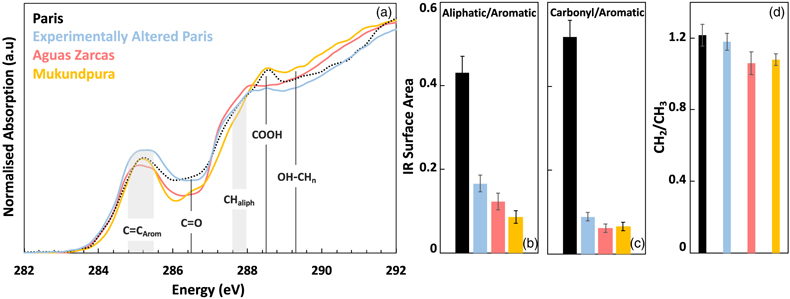
Figure 1 Spectroscopy investigations. (a) Speciation of organic carbon using near edge X-ray absorption fine structure for Paris (black), the experimentally altered Paris (‘Altered Paris’, blue), and altered CM2 Aguas Zarcas (pink) and Mukundpura (yellow) IOMs. The spectra are dominated by aromatic, carbonyl or carboxylic functional groups, with only a minor contribution of aliphatic groups. (b, c), Relative evolution of infrared surface area for aliphatic and carbonyl bands, relative to aromatic carbon. (d) Intensity ratio for aliphatic CH2 (2925 cm−1) and CH3 (2960 cm−1) bands.
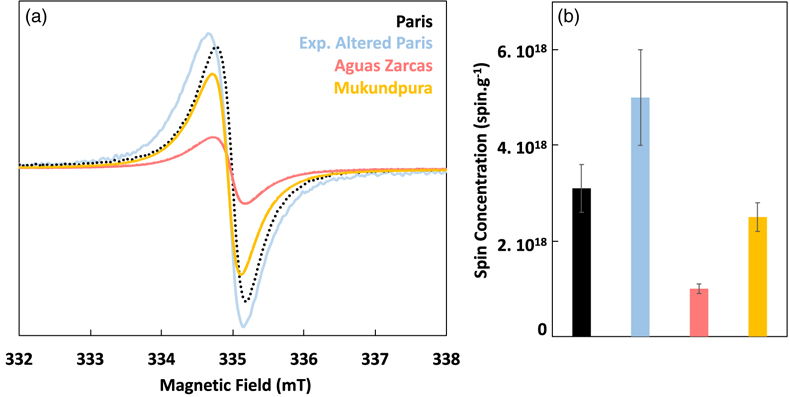
Figure 2 Detection of organic radicals after experimental alteration. (a) Spectra (microwave absorption derivative) at 280–285 K for experimentally altered Paris (blue), CM2.7 Paris (black) and CM2.2 Aguas Zarcas (red) and CM2.0 Mukundpura (yellow). (b) Concentrations of radicals at 280–285 K.
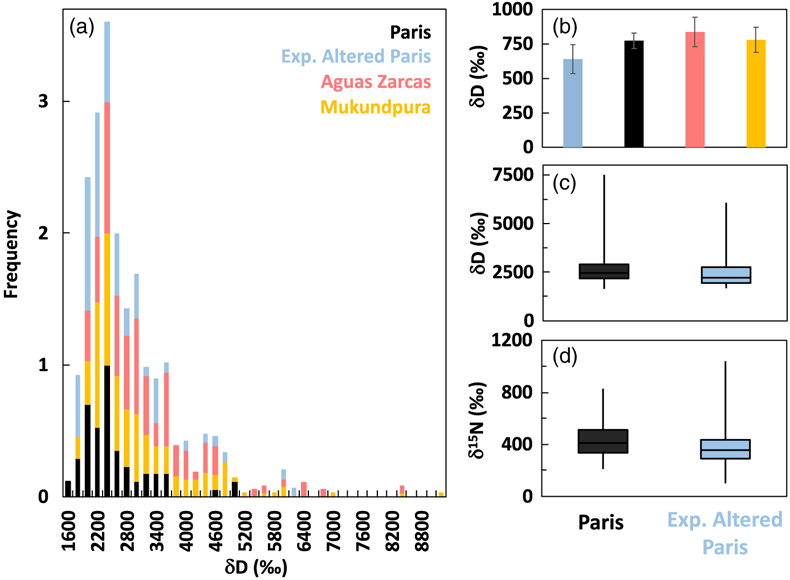
Figure 3 NanoSIMS investigations. (a) Normalised deuterium-rich hotspot distributions in IOM and bulk hydrogen isotopic compositions of Paris (black), experimentally altered Paris CM2 Aguas Zarcas (pink) and Mukundpura (yellow). Distribution are normalised to the number of occurrences and stacked. (b) The bulk hydrogen isotopic compositions of the different CMs and the experimental residue. (c, d) Evolution of the hotspot signatures for hydrogen (analysed on 3600 μm2 surface) and nitrogen isotopes (analysed on 2400 μm2 surface; images are reported on Fig. S-4).
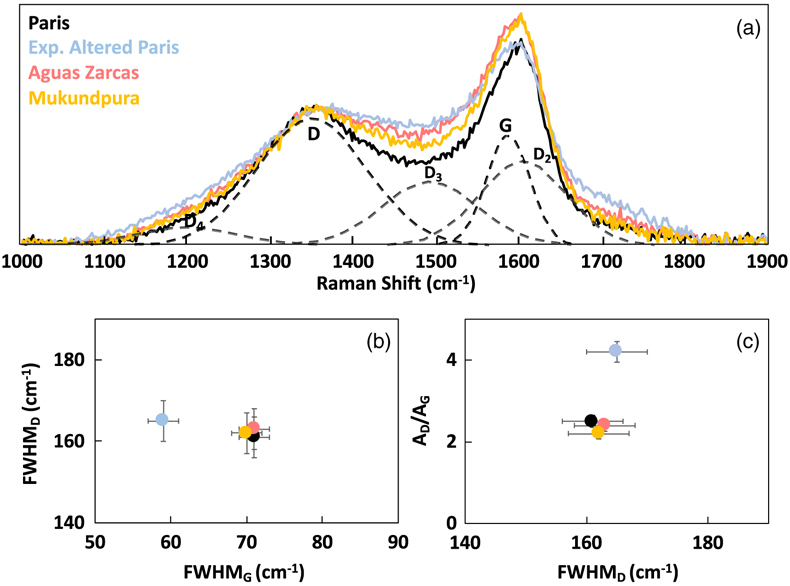
Figure 4 Structural evolution of Paris IOM under asteroidal conditions. (a) Raman spectra of Paris (black), experimentally altered Paris H2O (‘Altered Paris’, blue), and altered CM2 Aguas Zarcas (pink) and Mukundpura (yellow). Positions of G, D and minor defect bands are also reported. (b) Comparison of Raman D and G band widths for Paris (black), experimentally altered Paris (blue) and altered CM2 Aguas Zarcas (pink) and Mukundpura (yellow). (c) Evolution of band surface area ratio as function D band width for altered Paris, and the natural objects.


